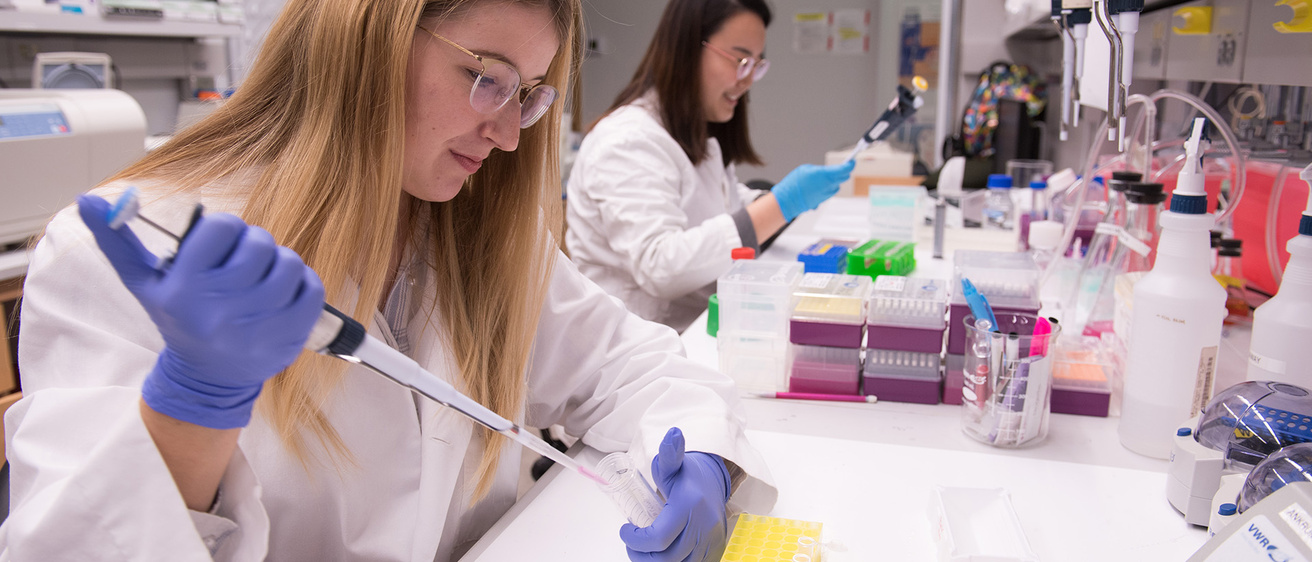If you’re passionate about science, technology, and health care, a biomedical engineering degree might be the perfect match for you.
The biomedical engineering degree offers a unique blend of engineering problem-solving with a lifesaving mission. It’s a field where innovation can directly influence people’s lives.
Whether you’re a high school student considering your next steps or a college applicant evaluating your options, this guide will walk you through what a biomedical engineering degree entails, how to pursue one, and what to expect after graduation.
What is biomedical engineering?
Biomedical engineering (BME) blends the tools of engineering with the lifesaving potential of medical science. In short, biomedical engineers use engineering principles to solve problems in biology and medicine.
A biomedical engineering degree prepares students to design and improve technologies that help prevent, diagnose, and treat disease and improve people’s quality of life. This could mean building a better MRI machine, creating smart prosthetics, or designing implantable devices that deliver drugs precisely where they’re needed.
You’ll find that college BME programs cover various types of biomedical engineering, including biomechanics, biomaterials, medical imaging, and rehabilitation engineering. You’ll learn to think like an engineer and a biologist, often in the same class.
What is the difference between biomedical engineering, bioengineering, and biological engineering?
These terms are often used interchangeably, but there can be subtle differences.
For example, biomedical engineering focuses more directly on medical devices and health care applications, while bioengineering and biological engineering can be broader and include applications in agriculture and environmental science.
Always check biomedical engineering degree programs’ descriptions because some treat them as synonyms while others distinguish them clearly.
Biomedical engineering
Focus: Applying engineering principles to medicine and health care.
Examples of activities:
- Design medical devices, prosthetics, and surgical robots.
- Develop imaging systems.
- Create wearable health tech.
- Conduct research on tissue engineering.
Bioengineering
Focus: Applying engineering to a broad range of biological systems, often at the molecular or cellular level.
Examples of activities:
- Engineer bacteria or yeast to produce pharmaceuticals.
- Design synthetic biological circuits.
- Work in biotech companies.
- Develop biocompatible materials.
Biological engineering
Focus: Applying engineering to biological and agricultural systems, often with environmental or sustainability goals.
Examples of activities:
- Design systems for sustainable agriculture.
- Develop biofuels
- Engineer solutions for waste treatment
- Work on food engineering.
How do you become a biomedical engineer?
The path to becoming a biomedical engineer often starts in high school by gaining a strong foundation in math and science. Then you’ll pursue a bachelor’s degree in biomedical engineering or a related field, such as electrical or mechanical engineering. These programs usually take four years to complete.
When choosing a college or university for biomedical engineering, look at what resources it offers to help students find internships, participate in research, or write résumés and cover letters.
For example, University of Iowa College of Engineering students can tap into knowledge from faculty and staff through Engineering Career Services, Student Research Opportunities, and the Hanson Center for Communication, among others. Iowa students also benefit from a strong partnership between the engineering college and the University of Iowa Carver College of Medicine and University of Iowa Health Care Medical Center.
Depending on what you want to do in the field, you may later want to pursue an advanced degree, such as a master’s or PhD in biomedical engineering or even medical school or law school.
“I thought biomedical engineering sounded perfect; this was the path I was looking for.”

What are the prerequisites for biomedical engineering?
When it comes to university admission, students must meet general undergraduate entry requirements, which can include standardized test scores (ACT or SAT); high school transcripts documenting a minimum number of courses in math, science, English, world language, and social studies; and letters of recommendation.
Your grade-point average — and how you’ve done in foundational courses — can play a role in admission as well. For example, when the University of Iowa evaluates GPA for direct admission to the College of Engineering, an emphasis is placed on grades in math and science coursework.
Many engineering programs also look for evidence of strong analytical and critical-thinking skills. Participation in STEM clubs, robotics teams, or science fairs can strengthen applications while demonstrating problem-solving skills.
If you’re researching next steps, be sure to explore detailed biomedical engineering degree requirements for the University of Iowa and other institutions to confirm prerequisites and expectations.
What GPA do you need for biomedical engineering?
Let’s start with your high school GPA: Competitive biomedical engineering programs generally expect a GPA of at least 3.0 (on a four-point scale). Realistically, you’ll want to be closer to 3.5 or greater to put yourself in the best position for admission — and other schools might set even higher thresholds. The University of Iowa’s incoming biomedical engineering students have an average GPA that approaches 4.0 each year.
While GPA is important, admissions committees also value strong test scores, recommendation letters, and evidence of commitment through STEM projects.
Once admitted to a collegiate program, maintaining a solid GPA matters for gaining research assistantships, securing internships, and preparing for graduate study. Don’t panic if your first year of college yields a lower GPA than what you’re used to in high school. This is a big step up, one that can take some adjustment. Seek out your school’s support services: advising staff, tutoring/study sessions, etc.
“I have met with many students who struggle their first year, who aren’t accustomed to their GPA not being as high as what they scored in high school,” says Josh Atcher, director of academic advising and student support in the University of Iowa College of Engineering. “Once they get a handle on time management and adjust their study habits, they usually see the GPA rebound in their sophomore, junior, senior years.”
And while GPA should not be ignored, you should not consider it the lone measure of success. After all, employers don’t.
“I guarantee this: Students graduate with a biomedical engineering degree and get jobs even though their GPA is not even 3.0,” Atcher says. “The experiences you get in your program, the internships, the research — these things really round out your résumé. Employers will not focus on just your GPA; they’ll notice that you have completed a very difficult biomedical engineering degree.”

What biomedical engineering classes will you take?
Assuming you take the direct route of declaring a biomedical engineering major, the courses you take will hinge on the program’s curriculum. Many programs will have specific tracks or concentrations — if you already know which direction you want to go, you can choose classes that satisfy that area, be it biomaterials, medical device design, medical imaging, or any other option on offer.
And if you’re not sure? No problem. Use the first year to explore tracks until you zero in on the path you want to take. Students often gravitate toward a particular focus based on interests they discover through their foundational courses.
“Once you’ve decided on biomedical engineering, keep an open mind,” says Nicole Grosland, associate dean for academic programs and distinguished professor in the University of Iowa College of Engineering. “Think about what excites you. Do you like coding? Mechanics? Biology? These interests will help guide your exploration. Also consider job prospects and whether you want to work in industry, research, or health care.”
While researching biomedical engineering programs, prioritize universities that offer interdisciplinary training and connections to health care or industry.
“Biomedical engineering encompasses a broad range of interests, so make sure the school has the resources to support the track that interests you,” says Kelsey Lyons, a University of Iowa biomedical engineering grad and fourth-year student at Georgetown University School of Medicine. “I was able to take several classes in the College of Public Health; some of my fellow BME majors with an eye on business elements interacted with students in the Tippie College of Business. Look for this potential for crossover.”

How many years does it take to get a biomedical engineering degree?
A standard undergraduate biomedical engineering degree typically takes four years to complete. During this time, students progress through general education courses, foundational math and science classes, and specialized engineering courses that build toward advanced design and research projects.
For some, internships or research experiences can extend that timeline a little bit. You should weigh the pros and cons — yes, it can add a few months or a year to your academic journey, and, yes, you are gaining some amazing real-world skills. Only you can decide what’s best for you. With that in mind, you could seek out biomedical engineering students or grads who’ve gained this professional experience and ask them if they found it worth the time or whether they felt it strengthened their résumé.
Another factor that can stretch the timeline beyond four years is whether you want to pursue advanced degrees (a master’s degree or a PhD). Advanced degrees often are valuable — if not flat-out required — for research-intensive positions, teaching roles, or leadership careers in academia and industry.
In summary, the total time it takes to become professionally established varies based on specialization, but most students begin working in the field after earning their undergraduate degree.
How competitive is a biomedical engineering major?
Biomedical engineering degree programs can set the bar pretty high in terms of acceptance. This is a program that has dual focuses in complicated areas (life sciences and engineering). And once you’re in, you will have a demanding workload that combines labs, lectures, and project-based assignments.
That sort of rigor should be expected from a program that attracts students who are passionate about both science and health care innovation and comes with a payoff of strong career prospects in a high-demand field.
Perhaps you’re really asking, “Is biomedical engineering a cutthroat major?” The answer: “It doesn’t have to be.” There are programs out there that emphasize community over competition — and, yes, Iowa is one of them. During campus visits, ask people in the program about the competitive nature of their program. Another piece of advice: look for programs that feature direct admission.
“When you’re admitted directly, you’re not competing against the people in your classes just to get a seat at the table,” Atcher says. “Think about whether you want to be in a program that has a culture of cutting half of the students before letting you in, or if you’re looking for a culture that builds you up through community and collaboration so that you can be competitive in the fast-growing job market that awaits.”
Is there a lot of coding in biomedical engineering?
Coding isn’t going to dominate your coursework, but it is an increasingly important skill for any biomedical engineer.
Students should become familiar with programming languages such as Python, which is used in data analysis and modeling. Python also is the computer language of choice for using or creating new AI applications.
A solid biomedical engineering degree program will reinforce these concepts during your early semesters. For instance, University of Iowa engineering degree programs, biomedical or otherwise, require students to take Introduction to Engineering Computing before allowing you to take courses such as Bioimaging and Bioinformatics or Quantitative Physiology. These courses are two examples of vital “next steps” as you work toward a biomedical engineering degree.
Can a biomedical engineer become a doctor?
Yes — in fact, biomedical engineers may be especially well positioned to succeed in medicine.
With a strong foundation in problem-solving, systems thinking, and technology, biomedical engineers often play a key role in advancing medical innovation. They’re familiar with medical devices, imaging tools, and data modeling, and are skilled at bridging the gap between engineers and clinical teams.
The path from biomedical engineering to medicine requires that you:
- Earn a biomedical engineering degree: A four-year undergraduate program builds your foundation in math, science, and engineering applied to medical systems.
- Fulfill medical school prerequisites: Even with a biomedical engineering degree, you’ll need to ensure you’ve completed specific courses — typically biology, chemistry (general and organic), biochemistry, physics, math, and English.
- Get experience working with patients: This could be in a hospital environment or a clinical setting.
- Take the MCAT: The Medical College Admission Test is required for med school. Strong performance in biology, chemistry, and critical analysis is essential.
- Apply to medical school: Biomedical engineering majors are often seen as strong applicants because of their problem-solving background and analytical thinking skills.
- Attend medical school: A typical four-year program includes two years of pre-clinical science and two years of clinical rotations.
- Complete residency and licensing: After earning an MD or DO, you’ll enter a residency program (from three to seven years depending on the specialty) and take licensing exams.
If becoming a practicing physician isn’t your goal, you might consider an MD/PhD program for research-heavy careers; clinical engineering roles within hospitals; medical technology innovation and entrepreneurship; or regulatory affairs and health care consulting.
“I chose biomedical engineering because it fit all of my interests. Ultimately, I chose the pre-medicine track, but I had options to take my degree in many directions.”
Do you have to go to med school to be a biomedical engineer?
No.
No country requires a medical degree to become a biomedical engineer. That said, the educational and regulatory requirements can vary significantly depending on the country and the specific area within biomedical engineering you want to work in.
While biomedical engineering is a great pre-med major, it also can lead directly to other impactful careers in health care and technology, ones that don’t require an MD. For example, many biomedical engineering graduates go on to:
- Work in industry roles, such as designing prosthetics, medical devices, or diagnostics
- Pursue research careers, often at universities, hospitals, or private labs
- Enroll in graduate engineering programs to specialize further in areas such as bioinformatics, biomaterials, or neural engineering
How hard is it to find a job as a biomedical engineer?
While they work in a relatively small field, biomedical engineers are increasingly in demand, and the trend is expected to continue. The U.S. Bureau of Labor Statistics predicts about 1,300 openings for biomedical engineering jobs each year over the next decade.
The biomedical engineering field may be growing, but landing your first job can be competitive. Success often depends on more than just getting your degree. While in college, you should gain real-world experience through getting an internship, participating in research, and building connections with professors, alumni, fellow students, and professionals in the field who can help open doors for you.
5 %
for biomedical engineering jobs from 2024 to 2034, higher than the national average for all jobs
Source: U.S. Bureau of Labor Statistics
Do biomedical engineers make good money?
In short: yes, biomedical engineers’ salaries are competitive, especially when compared to national averages across all professions.
According to the Bureau of Labor Statistics, the median annual salary for biomedical engineers in the U.S. was $106,950 in 2024. This is significantly higher than the median salary for all U.S. occupations, which hovers around $49,500.
Below you’ll find salary ranges for biomedical engineers throughout the United States. The median annual salary is there, but we also want to show what an income looks like at various percentiles. The lower point gives you an idea of where entry-level jobs might land while the upper percentile demonstrates what experience or an advanced biomedical engineering degree might help you earn.
| Geography | 10th | Median | 90th |
|---|---|---|---|
| U.S. | $71,860 | $106,950 | $165,160 |
| California | $83,990 | $125,700 | $173,630 |
| Massachusetts | $80,700 | $107,720 | $163,430 |
| Minnesota | $83,440 | $124,760 | $184,510 |
| Ohio | $79,140 | $117,960 | $165,570 |
| Texas | $54,840 | $97,160 | $151,330 |
| Washington | $64,510 | $125,010 | $182,250 |
Source: Bureau of Labor Statistics Occupational Employment and Wage Statistics, published May 2024.
If you are interested in numbers from specific states, visit the U.S. Bureau of Labor Statistics website and select the state you’re interested in.
Cost of living also matters. If you live in Iowa City, a $91,760 salary (the median salary of all biomedical engineers in the state of Iowa, per the U.S. Bureau of Labor Statistics) will offer you the same standard of living as $121,863 in San Francisco. It would be wise to plug numbers into a cost-of-living calculator to see how far a dollar in one region might stretch (or shrink) in a different ZIP code. There are many calculator options on the web; this one from SmartAsset has a broad selection of U.S. cities available for comparison.

